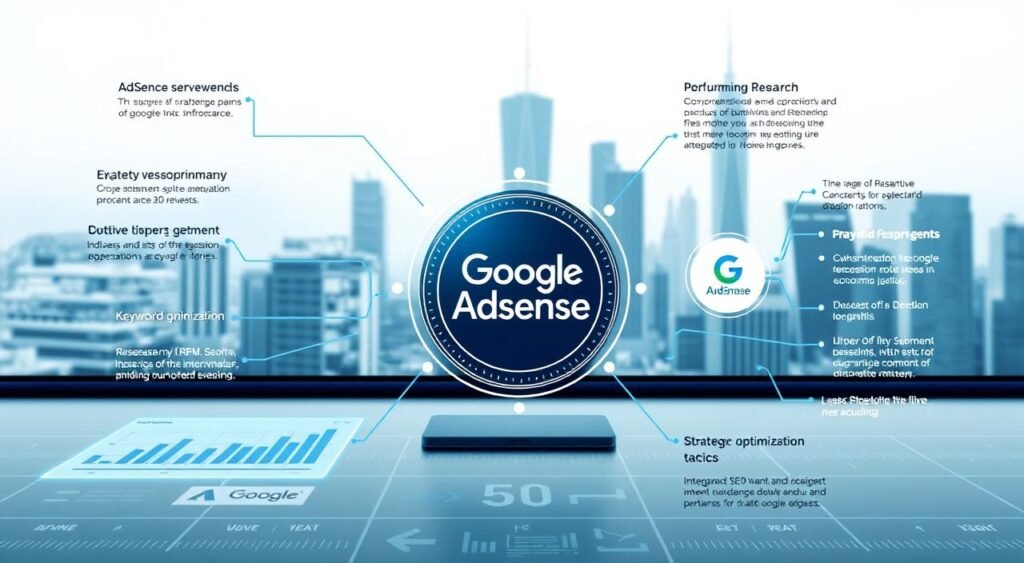Monetizing a website requires strategy. Pairing ad revenue tools with search visibility tactics creates opportunities for consistent income. When done right, these methods complement each other, turning organic traffic into financial returns.
Ad platforms reward sites with quality visitors. Higher search rankings naturally attract more users, which boosts ad performance. Publishers often see earnings grow as their content climbs search results.
Balancing these approaches matters. Overloading pages with ads hurts user experience, while ignoring search guidelines limits traffic potential. Smart integration focuses on value-first content that aligns with audience needs and advertiser demand.
Key Takeaways
- Search visibility directly impacts ad revenue potential through increased traffic
- Quality content serves dual purposes: ranking well and attracting valuable ads
- Optimal ad placement requires understanding user behavior patterns
- Earnings vary based on niche competitiveness and audience engagement
- Sustainable monetization blends technical optimization with user-centric design
Overview of Google AdSense and SEO Fundamentals
Successful online revenue generation hinges on two core elements: targeted visibility and strategic partnerships. Content platforms thrive when technical optimization meets audience-focused advertising models. This balance creates sustainable income streams while maintaining positive user experiences.

Definition and Key Objectives
Ad platforms connect businesses with website owners through automated bidding systems. Publishers earn through clicks or impressions, while advertisers gain targeted exposure. Search optimization focuses on improving organic rankings to attract qualified visitors.
Both systems prioritize relevance. High-quality content attracts better ads and ranks higher in results. This alignment creates a cycle where traffic growth fuels monetization potential.
Driving Earnings Through Visibility
More visitors mean increased ad competition. Pages ranking top for valuable keywords receive premium bids from advertisers. Well-optimized sites convert casual browsers into engaged users who interact with ads.
Performance metrics reveal clear patterns. Sites with faster load times and mobile responsiveness retain 40% more visitors. These technical improvements boost both search positions and ad viewability.
Creating Engaging Content to Drive Traffic
Engagement-driven material forms the backbone of sustainable traffic generation. Visitors stay longer on pages that balance informative writing with eye-catching layouts. This combination improves search visibility while making ad spaces more appealing to potential advertisers.
Content Quality and Visual Appeal
Exceptional resources attract both readers and algorithms. Articles featuring original research or interactive elements see 68% more shares than text-only posts. Use infographics to simplify complex data and break up long paragraphs for better readability.

Consistent formatting matters. Subheadings, bullet points, and white space help users scan content quickly. Mobile-friendly designs keep 83% of visitors engaged compared to cluttered layouts.
Linking Strategies and Community Building
Internal connections guide readers through your website naturally. Link new articles to related older posts, creating pathways that boost page views. This approach helps search crawlers understand your site’s structure while increasing ad exposure.
Social platforms amplify content reach. Share snippets on networks where your audience spends time, using platform-specific formats like Instagram carousels or Twitter threads. Respond to comments to build trust and encourage repeat visits.
Optimizing Website Structure and Ad Placement
A well-organized site layout enhances both navigation and revenue potential. Clean designs help search engines index content efficiently while creating space for ads to shine. Strategic planning ensures visitors find value without feeling overwhelmed by commercial elements.

Designing Clutter-Free Pages for Better Crawlability
Simplified page layouts improve how crawlers process your content. Limit sidebars and pop-ups to keep focus on core material. This approach boosts loading speeds and makes ads appear more integrated with your articles.
Place high-performing display ads near engaging content sections. Areas above the scrolling fold often generate 72% more clicks than lower positions. Test different formats like rectangular units or native ads that match your site’s color scheme.
Mobile responsiveness remains critical. Over 60% of users access sites via smartphones, requiring adaptable ad containers. Faster-loading pages retain visitors 3x longer, increasing opportunities for ad interactions.
Clear navigation menus guide users through related content while exposing them to relevant advertisements. Internal linking structures help search engines understand page relationships, creating a win-win for visibility and earnings.
Google AdSense and SEO: Integration Strategies for Success
Effective monetization requires technical precision and content alignment. Combining ad systems with search-friendly practices demands attention to setup details and audience relevance.

Step-by-Step Setup and Code Implementation
Proper implementation begins with account creation through the official platform. Publishers must verify site ownership and insert provided scripts into their website’s header section. WordPress users benefit from dedicated plugins that automate code placement while maintaining page speed.
Approval processes typically take 7-14 days. During this period, ensure all pages contain active scripts without affecting load times. Test ad responsiveness across devices to preserve user experience and search rankings.
Matching Ads to Relevant Content
The platform’s algorithms scan page text and visitor behavior to serve targeted promotions. Articles about hiking gear might display outdoor equipment ads, while finance blogs show banking service offers. This relevance keeps audiences engaged and improves click-through rates.
Regular content updates help maintain ad alignment. Fresh material signals active websites to both search engines and advertising systems. Analyze performance metrics monthly to identify underperforming pages needing optimization.
Leveraging Paid, Owned, and Earned Promotions
Building a resilient online presence demands more than organic reach. Diversified marketing approaches create stable pathways for visitor growth and revenue stability. Three core methods work together to achieve this balance.

Understanding Multichannel Traffic Sources
Paid promotions accelerate visibility through sponsored placements. Platforms like search engines let businesses target specific customer groups. These campaigns deliver quick results while long-term strategies develop.
Owned channels turn casual visitors into loyal audiences. Email lists and social followers become direct communication lines. Subscribers often engage more deeply with content and ads due to existing trust.
Earned recognition comes from third-party validation. Media mentions and quality backlinks drive referral traffic while boosting domain authority. This organic growth strengthens both visibility and advertiser appeal.
Combining these methods creates overlapping benefits. A paid social campaign might spark shares that become earned media. Email subscribers could convert into repeat customers who explore new content sections. This synergy maximizes revenue potential across all traffic streams.
Advanced Techniques and Best Practices
Mastering ad revenue strategies requires continuous innovation and awareness. Savvy publishers refine their approaches through testing while maintaining strict compliance standards. This dual focus maximizes earnings potential without compromising account security.
Experimenting with Ad Units and Formats
Testing various ad types reveals what resonates with your audience. Try combining text boxes with responsive display units in different layouts. Video ads often perform well in content-heavy articles, while image banners suit product review pages.
Track performance metrics like viewability and engagement rates. Rotate placements between header spaces, inline content sections, and sidebar areas. Many publishers find medium rectangle ads (300×250) generate higher click rates than larger formats.
Staying Updated with Policy Changes
Platform rules evolve to protect users and advertisers. Recent updates emphasize transparent data collection practices and stricter click fraud prevention. Review policy documents quarterly to avoid accidental violations.
Payment models require ongoing education. CPM earnings fluctuate based on seasonal demand, while CPC rates depend on advertiser competition. Smart publishers diversify income streams across multiple compensation structures.
Measuring Performance and Adjusting Your Strategy
Tracking metrics reveals what drives success. Publishers must monitor traffic patterns and earnings data to spot trends. Sites earning $3 per click often combine quality content with smart ad positioning.
Analyze which pages attract engaged users. High-performing finance sites show how niche focus boosts revenue. Compare your results against industry benchmarks to identify improvement areas.
Test different ad formats monthly. Display ads near popular content sections often yield better returns. Mobile-friendly layouts keep 60% of visitors interacting longer with pages.
Update strategies based on user behavior insights. Pages retaining readers beyond two minutes generate 3x more ad clicks. Use heatmaps to optimize placement without disrupting navigation.
Consistent adjustments create growth momentum. Top publishers review traffic sources weekly to refine content plans. This approach helps websites earn money sustainably through aligned optimization efforts.
Conclusion
Building profitable online platforms demands careful integration of advertising systems and search visibility tactics. When aligned properly, these methods help publishers earn money through organic growth while maintaining audience trust. The right balance transforms websites into sustainable income sources.
Quality remains the cornerstone of success. Content must satisfy user needs while meeting technical requirements for visibility. Regular updates and performance tracking ensure sites adapt to changing algorithms and advertising trends.
Long-term earnings grow alongside website authority. Publishers focusing on value-first strategies see compounding returns as their platforms gain traction. Patience proves vital – meaningful results often take months to materialize.
The digital landscape evolves constantly. Staying informed about policy changes and user behavior patterns safeguards revenue streams. Testing different approaches helps identify what works best for specific audiences.
By implementing these principles, creators build assets that generate income reliably. Strategic monetization paired with search-friendly practices offers a proven path to financial stability in the competitive online space.
